A once protracted, complex and often cumbersome task, spectroscopic analysis is becoming more accessible, opening the door to greater industrial and consumer applications.
From food safety and manufacturing efficiency, to environmental testing and medical diagnosis, optical spectroscopy is already an indispensable tool across several industries. Today, thanks to miniaturization of instruments and sophisticated advances in technology, spectroscopy is increasingly used to address the demands of a modern world.
With evermore emphasis placed on production quality, the need to protect the environment and the threat of global terrorism, there is a growing demand for interrogation of substances, which is bringing spectroscopy into new markets.
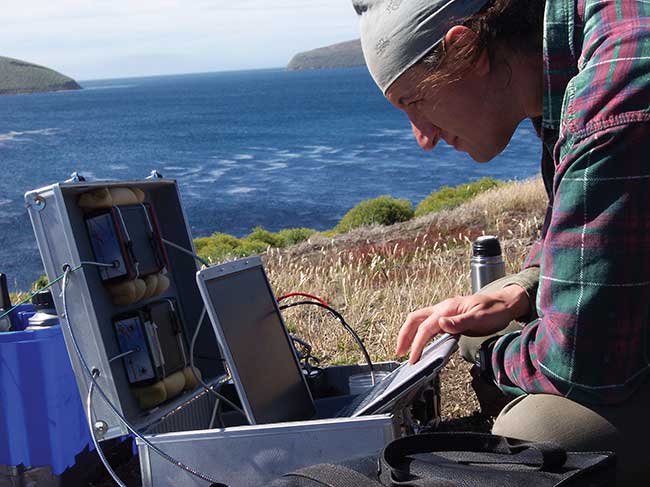
Scientists are using portable spectrometers to study the thin-billed prion, a species of seabird that is mostly found in the southern oceans that can see and produce signals in the UV range (such as plumage color and bill displays). Spectroscopy allows researchers to objectively assess skin and feather colors. The spectrometer used here on New Island, part of the Falkland Islands, is an AvaSpec-2048 in a portable setup with a laptop, 12-V battery, a light source and a connected reflection probe. Courtesy of Avantes BV.
Today, optical spectroscopy is used to screen liquids in bottles at airports, as well as for detecting improvised explosive devices. Drug tablets and capsules are analyzed for proper composition. The detection of phthalates — chemicals that make plastics more pliable or harder to break — in children’s toys are emerging applications benefitting from spectroscopic techniques.
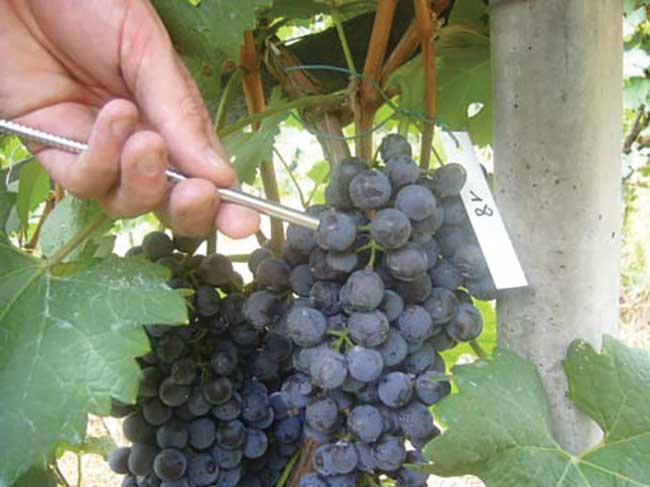
Grape composition at harvest is the primary determinant of future wine quality. Several factors are considered in grape composition, including familiar ripeness indicators such as soluble sugar content and acidity, as well as phenolic compounds anthocyanins and polyphenols. Avantes has developed a portable VIS/NIR optical measurement system for quick, nondestructive grape quality measurements. Courtesy of Avantes BV.
This growing market trend is reflected in a report published in January 2017 by Research and Markets (Global Molecular Spectroscopy Market: Trends and Forecast to 2024) that predicts this market will reach $6.7 billion by 2024 at a compound annual growth rate of 5 percent from 2017 to 2024.
Tunable IR spectroscopy
Almost 50 years on from the release of the first Fourier transform infrared (FTIR) spectrometer, the emerging availability of tunable IR quantum cascade lasers (QCLs) is causing a flurry of activity, particularly in niche applications. As QCL devices progress, spectroscopy vendors are starting to utilize a new intense, tunable — but relatively expensive — light source for IR spectroscopy.
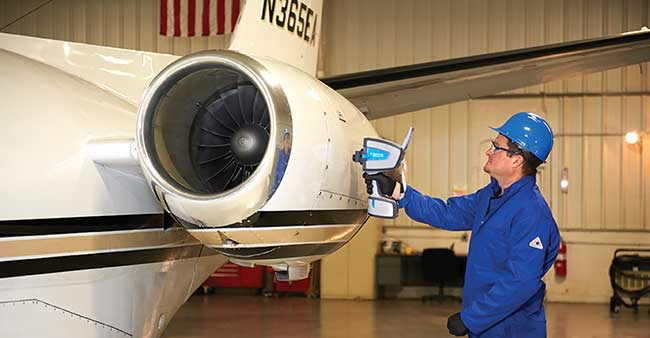
The Agilent Aerospace Analyzer is a handheld, portable, mid-IR Fourier transform spectrometer (FTIR) that is specifically equipped to provide high-quality, nondestructive analysis of aerospace materials including composites, polymers, coatings and metal surfaces. The instrument package is calibrated and validated for the analysis of thermal damage on state-of-the-art composite aircraft. Courtesy of Agilent.
“The infrared spectroscopy community has followed the development of QCL technology with interest for some time,” said Andrew Hind, general manager of Molecular Spectroscopy within Agilent Technologies’ Life Sciences and Applied
Markets Group. “Barriers to entry to this market have primarily been QCL frequency range, or ‘tunability,’ and cost. However, recent advances have seen QCL technology moving into the IR spectroscopy space.”
Today, such instruments are emerging with good signal-to-noise, a fairly wide spectral range and increasingly straightforward sample interfaces. They easily achieve the spectral resolution required for analytical spectroscopy; however, they are not expected to entirely replace FTIR spectrometers.
This is because QCLs can’t cover the full wavelength range from 2.5 to 25 µm. And while a reasonable FTIR now costs about $15,000, one can easily spend the same on the lasers alone for a QCL-based system.
Although QCLs are not expected to completely oust FTIR spectrometers in the next 10 years, for applications where power is paramount, they will. Two such cases are protein conformation analysis in water and infrared microscopy of biological systems.
For example, RedShift BioAnalytics of Burlington, Mass., has developed a QCL-based system for protein secondary structure analysis, using microfluidics to permit quasi-real-time referencing between the sample and a reference buffer. This has potential applications in biologics, from discovery to manufacturing.
Spectroscopic tissue pathology, and the instrumentation required, have been extensively studied by Rohit Bhargava at the University of Illinois, among others.
Bhargava and colleagues have coupled a rapidly tunable QCL with a high-performance microscope equipped with a cooled focal plane array (FPA) detector. Multiple QCL units are multiplexed together to provide spectral coverage across the fingerprint region (776.9 to 1904.4 cm-1) resulting in what the team claims to be spectral and spatial fidelity that is at least as good as the best FTIR imaging systems.
While initial marketplace entry is limited, Daylight Solutions of San Diego currently offers a commercial QCL microscope instrument, and Agilent has a prototype QCL-based system using a different principle from that employed by Daylight Solutions.
“QCLs will find niches where their cost, limited spectral range, high brightness and focusability are advantages,” said Richard Crocombe, principal consultant at Crocombe Spectroscopy Consulting. “In those developments, attention needs to be paid to QCL’s noise characteristics — more signal does not help if the noise increases proportionally.”
In another IR approach, terahertz spectroscopy is beginning to show promise. According to Daniel Weibel, global product manager of Trace Organic Analysis and Sensorics at MilliporeSigma, IR terahertz spectroscopy has the potential to become a disruptive technology thanks to the remarkable properties of terahertz light.
This nonionizing radiation can reveal details that other light simply cannot reach. Many common materials and living tissues are semitransparent at terahertz frequencies and show characteristic fingerprints that can be used for analysis and identification in materials science.
“The range of applications is very broad, ranging from the analysis of formulations in the pharmaceutical industry over detection of hidden objects in safety applications to detection of defects in solar panels and highly sensitive, noninvasive detection of cancerous tissues,” Weibel said.
Raman flourishes
It’s an exciting time for Raman technology, especially in mapping and imaging, where the wavelength of the exciting laser means the spatial resolution is better than can be achieved by conventional IR spectroscopy.
Recent advances in spatially offset Raman spectroscopy (SORS) and transmission Raman spectroscopy (TRS) are driving it into the pharmaceutical, detection and security markets.
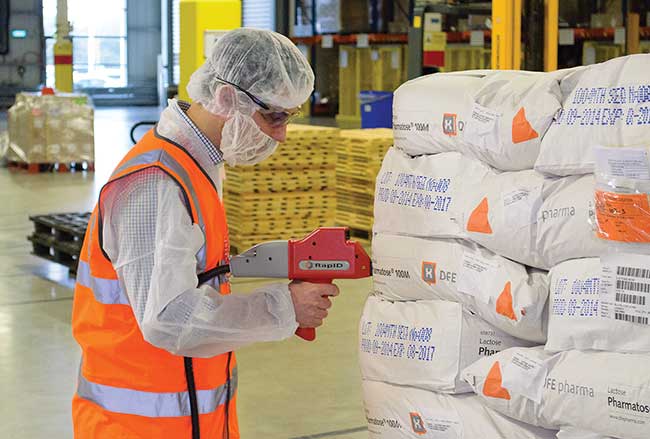
Spatially offset Raman spectroscopy (SORS) works through many millimeters of material, enabling accurate chemical analysis through barriers such as paper, glass, plastic, fabric and skin. This makes it ideal for through-barrier hazardous material identification. Courtesy of Agilent.
In July 2017, Agilent acquired U.K.-based Cobalt Light Systems, including its SORS technology, which Crocombe predicts will take the technique into the mainstream, especially for pharmaceutical applications.
“SORS works through many millimeters of material, enabling accurate chemical analysis through barriers such as paper, glass, plastic, fabric and skin,” Hind said. “The method requires no prior knowledge of the container/surface material or direct physical contact. This makes it ideal for through-barrier hazardous material identification.”
Besides raw materials identification in pharmaceutical quality control, interest is emerging in SORS from those working with hazardous materials, explosive ordnance disposal, law enforcement and screening for explosives at security checkpoints.
Currently, with no universal method to detect liquid explosives, bottle liquid screening in airports is an increasing problem. Today, Raman-based systems from both Cobalt (now Agilent) and Smiths Detection are deployed in airports, but it remains to be seen whether advances in x-ray imaging will eventually supplant Raman spectroscopy in this application.
While traditional Raman methods rely on data collected from backscattering, which limits analysis of samples such as tablets and capsules to their surfaces, TRS permits nondestructive measurement through a powdered or solid sample (≥10 mm). Users can obtain data that is representative of the entire sample, not just the surface, with no sample preparation.
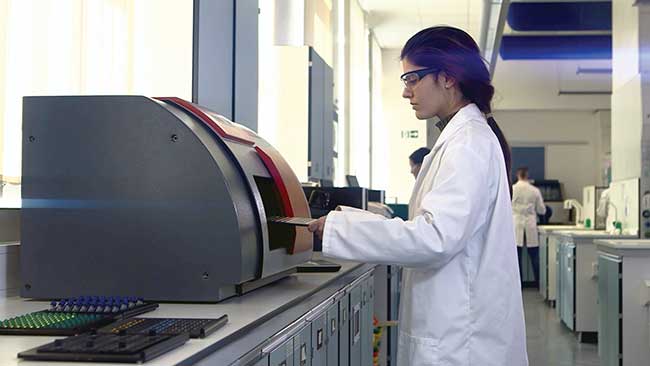
Transmission Raman spectroscopy (TRS) permits nondestructive measurement through a powdered or solid sample with applications in the pharmaceutical industry, detection and security markets. Courtesy of Agilent.
As such, TRS is well suited to the analysis of pharmaceutical tablets and capsules — specifically, the fast, quantitative analysis of final dosage forms and mixtures. TRS is also insensitive to variations in particle size, sample compaction and moisture, and is increasingly being adopted by Big Pharma in both R&D and manufacturing settings.
Automation and intelligence
Automation, along with increasingly intelligent software, has greatly expanded both capability and capacity, as well as reduced reliance on highly skilled operators. The result is that spectroscopy is deployed in more routine, downstream applications across a variety of industries, with automated and unattended operation progressively becoming the norm.
“Instrument developers have built in Ph.D.-level expertise into the instruments, along with specialized libraries and algorithms, to give the operator reliable, actionable information,” Crocombe said. “Today, results are presented via red screen/green screen, rather than by spectra or chromatograms, making complex analysis look much simpler.”
Taking the field of optics and coatings manufacture and metrology as an example, automation has made a significant impact on the entire value chain — from R&D to quality control. What was once a laborious and time-consuming task that involved multi-angle measurements can today be run in an automated and unattended fashion without the need to move the sample.
“It has started a trend of sophisticated measurement regimes moving from the R&D lab to the production line, increasing demand for these more automated workflow solutions,” Hind said.

Modern food production is increasingly turning to the science of spectroscopy to monitor crop health and improve production yields. Courtesy of Avantes BV.
Spectroscopy makers are also offering “fleet management” of these instruments, which, as Crocombe pointed out, is particularly useful in highly regulated industries such as pharmaceuticals. “[This] ensures that companies can control exactly what hardware, software, libraries and algorithms are being used by their personnel,” he said.
While most would welcome a significant increase in productivity, along with improvements in quality and reliability of a finished product, it may not be as straightforward as it seems. Some experts anticipate a major pitfall in this trend that relies heavily on software often written with little spectroscopy knowledge.
“Software is only as good as the technical understanding of the people who write it,” said Ellen Miseo, chief scientist at TeakOrigin Inc., a startup devoted to using spectroscopy to understand high-value foods. “I have had some notable conversations with software developers who wanted to interpret instrument noise as real signal and then predict parameters from noise. Obviously that is not going to work.”
Crowdsourced data conundrum
Another trend that could be cause for concern involves new communication protocols being adopted as standard across the industry. Ethernet, wireless and USB3 allow for the deployment of instruments into new environments without the limitation of being tethered to a nearby host computer.
All of this lends itself well to access the cloud and creates the opportunity to perform data processing of spectra in real time, remotely. Some startup companies are relying on their customers to crowdsource data for spectral libraries, but there are concerns about this.
“Crowdsourced data has all the problems of authenticity of the sample: How was the data collected? Was the data collected in a representative manner? Is the meta data right? And so on,” Miseo said. “All [of] these will impact how well sophisticated software can work.”
Today, spectroscopic measurements are increasingly being collected by nonspecialists. What was once only possible in the laboratory is now becoming field deployable, leading to a paradigm shift in the market. Handheld devices can now be brought to points-of-goods in pharma, food and the chemical industry for fast actionable results in situ.
“There is tremendous value in carrying out on-the-spot inspections,” Crocombe said. “Not only can it improve productivity, but it can also enhance safety and ultimately revolutionize the way a company or group does business.”
“This market shift stems from the overall trend of miniaturization both in sample volume as well as the development of smaller instruments. Novel instrument designs and new detectors are making it possible to pack better performance into smaller form factors,” he added.
“It is remarkable that the spectroscopy hardware has become noticeably smaller in the last few years without losing performance,” said Kurt Vorburger, Global Innovation manager at MilliporeSigma. “For example, mid-infrared spectrometers the size of a sheet of paper or smaller are common nowadays.”
Handheld FTIR
Handheld FTIR is rapidly becoming the tool of choice for nondestructive testing of primers, paints and composites. Applications in numerous other areas, such as art conservation, mineral and soil identification and the detection of phthalates in children’s toys, are also becoming more prevalent.
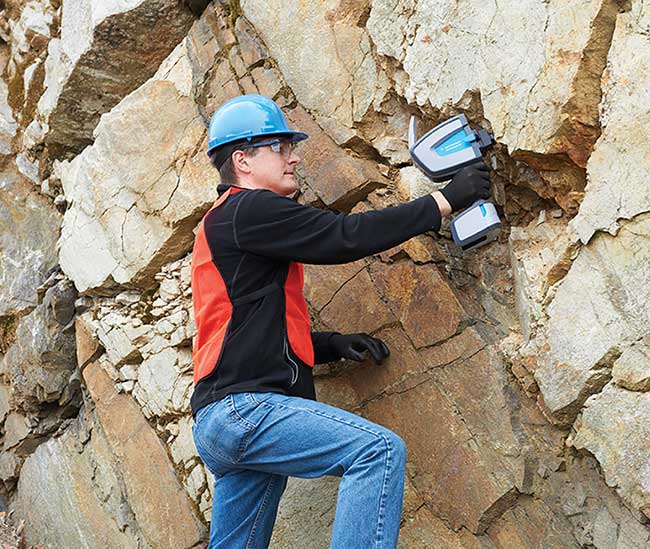
Handheld FTIR devices provide a lightweight, ergonomic, nondestructive spectrometer, which enables direct rock and mineral identification, and assessment of soil composition. Courtesy of Agilent.
“These smaller spectrometers are a boon to original equipment manufacturers and have the potential to fuel a rush in
development of commercial products utilizing spectroscopy,” said Benno Oderkerk, director and founder of spectroscopy specialist Avantes BV, with headquarters in the Netherlands. “We are seeing more mainstream adoption of Raman and LIBS [laser-induced breakdown spectroscopy] measurement techniques in industrial and even consumer applications.”
Handheld LIBS devices are being adopted to support recycling and mining, and even replacing x-ray fluorescence in some cases. Raman is advancing into process control and counterfeit detection, among others new areas.
“LIBS offers compelling advantages compared with other elemental analysis techniques — extremely fast measurement time, broad elemental coverage and no need for sample preparation,” Vorburger said.
The ongoing trend in miniaturization poses a challenge, however, and the caveat is that spectroscopic performance must remain “fit for purpose.”
“Large trade-offs in performance relative to size will unlikely be tolerated by the market,” Agilent’s Hind said. “Similarly, although we have seen continued improvement in the usability and accessibility of spectroscopic tools, the marketplace is still demanding a more modern and intuitive user experience.”
On the horizon
Optical spectroscopy has come a long way, and those who have been in the business the longest can attest to the unrecognizable changes that have occurred.
“When I was in grad school fighting with a 10-ft-long triple monochromator system, I never would have envisioned using a Raman the size of my handbag and being happy with the data,” Miseo said. “We have gotten here by revolutions in every single component — lasers, gratings, detectors, electronics, processing and software.”
Despite technological leaps and bounds, there are more advances on the way that could prove transformative. Raman is plagued by fluorescence that currently no amount of novel electro-optics has managed to tame. While ultraviolet Raman could be the solution, research is currently confined to the laboratory.
“Developments of novel light source technologies for the UV and broad spectrum sources that are tunable to overcome detector and grating response inefficiencies are definitely needed to support the demands of the industry,” said Oderkerk. “Avantes remains very optimistic about the future of spectroscopy and photonics in general.”
This optimism appears consistent across the industry, and with smaller and smarter spectroscopic devices combined with the cloud and Internet of Things, we may well soon witness the dawn of a new age of sensor networks and distributed, real-time detection.
According to Hind, “This is a construct that could completely, and irrevocably, change the industry as we know it.”